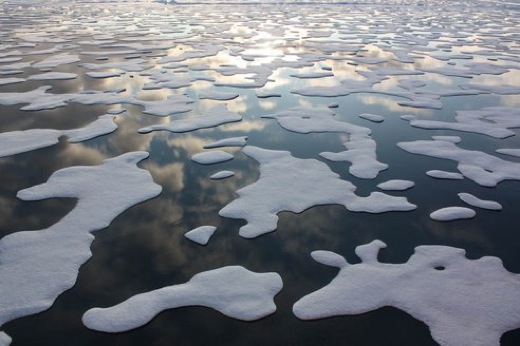SUBHEAD: Yesterday TreeHugger announced it might be time to join an end-of-world cult because of the pace of arctic permafrost melt.
By Matthew McDermott on 15 December 2011 for TreeHugger -
(http://www.treehugger.com/climate-change/arctic-methane-situation-really-bad-headlines-make-it.html)

Image above: Melting Arctic Ocean leads to release of undersea methane. From original article.
[IB Editor's note: The chief Science Editor for TreeHugger has a different view of arctic methane release.]
A few days ago the "shocking" headlines came out, describing some new research on how much methane is now seeping out of the Arctic seafloor—a greenhouse gas far more potent than carbon dioxide, but much shorter lived in the atmosphere—as the region warms and permafrost melts.
It wasn't the first research documenting this, as TreeHugger has reported over the past few years.
But is it really as bad as, in particular, The Independent, makes it out to be? Is it really time to join an end-time cult (if that ever really would be a good idea) as has been I presume tongue-in-cheek suggested? Massive and quick release of methane from melting permafrost would indeed be a pretty dire thing for the climate, but is it actually happening as has been popularly portrayed?
Perhaps not.
Dot Earth quotes from a summary of the research in question from the American Geophysical Union:
See also: Ea O Ka Aina: Permafrost melt accelerating 12/14/11
.
By Matthew McDermott on 15 December 2011 for TreeHugger -
(http://www.treehugger.com/climate-change/arctic-methane-situation-really-bad-headlines-make-it.html)

Image above: Melting Arctic Ocean leads to release of undersea methane. From original article.
[IB Editor's note: The chief Science Editor for TreeHugger has a different view of arctic methane release.]
A few days ago the "shocking" headlines came out, describing some new research on how much methane is now seeping out of the Arctic seafloor—a greenhouse gas far more potent than carbon dioxide, but much shorter lived in the atmosphere—as the region warms and permafrost melts.
It wasn't the first research documenting this, as TreeHugger has reported over the past few years.
But is it really as bad as, in particular, The Independent, makes it out to be? Is it really time to join an end-time cult (if that ever really would be a good idea) as has been I presume tongue-in-cheek suggested? Massive and quick release of methane from melting permafrost would indeed be a pretty dire thing for the climate, but is it actually happening as has been popularly portrayed?
Perhaps not.
Dot Earth quotes from a summary of the research in question from the American Geophysical Union:
The authors found that roughly 1 meter of the subsurface permafrost thawed in the past 25 years, adding to the 25 meters of thawed soil. Forecasting the expected permafrost thaw, the authors found that even under the most extreme climatic scenario tested this thawed soil growth will not exceed 10 meters by 2100 or 50 meters by the turn of the next millennium. The authors note that the bulk of the methane stores in the east Siberian shelf are trapped roughly 200 meters below the seafloor.Read more of the Dot Earth piece to get a more measured reading of the situation: Methane Time Bomb in Arctic Seas - Apocalypse Not
See also: Ea O Ka Aina: Permafrost melt accelerating 12/14/11
.
No comments :
Post a Comment